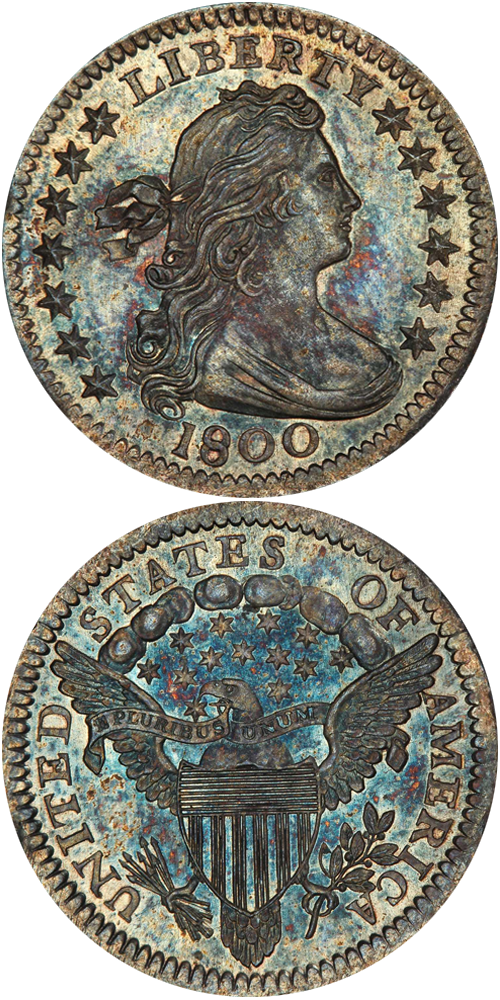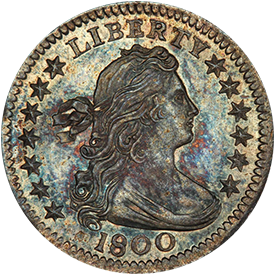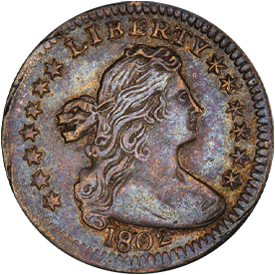Designed by: Robert Scot
Issue Dates: 1800-1805
Composition: 89.24% silver, 10.76% copper
Diameter: 16.5 mm
Weight: 1.34 grams (20.8 grains)
Edge: Reeded
Business Strike Mintage: 124,270
Proof Mintage: None
The half dimes of the 1800-1805 years continued the Draped Bust obverse used earlier in 1796-1797, except that the stars beginning in 1800 have been standardized to seven left and six right. The reverse is of the Heraldic Eagle style adopted from the Great Seal of the United States and used beginning in the preceding decade on certain other silver denominations. At the center is an eagle with a shield on its breast, holding in its beak a ribbon inscribed E PLURIBUS UNUM and grasping in its talon a bundle of arrows and an olive branch. Above the eagle is an arc of clouds under which is a group of stars. UNITED STATES OF AMERICA surrounds. No mark of denomination or value appears on the coin.
Half dimes of this era are scarce, with 1802 being a prime rarity. Most surviving examples of various 1800-1805 dates are seen in lower ranges of condition, from About Good to Very Good or so. Fine specimens are not easy to locate, Very Fine pieces are still more elusive, and Extremely Fine coins are rare. Strictly Uncirculated pieces are extremely rare. Those that do come on the market are apt to be dated 1800. Uncirculated specimens dated 1801, 1802, and 1803 (no pieces were coined in 1804), and 1805 are exceedingly rare or nonexistent. Nearly all known specimens exhibit a degree of light striking in one area or another, particularly on the high points of Miss Liberty's hair, among the obverse stars, and on the reverse among the stars above the eagle. Such striking characteristics are to be expected, and a numismatist seeking a perfectly struck, extremely sharp example in a high grade is apt to never encounter such a coin!
Further Reading
No half dimes were minted with the dates 1798 or 1799. A new design appeared in 1800. The obverse motif was the Draped Bust style as used earlier, but the reverse now displayed a Heraldic Eagle, somewhat resembling the Great Seal of the United States. Shown is a wing-spread eagle with stars and clouds above. The Heraldic Eagle is rather "traditional," and has appeared from time to time on our coinage. Used on silver and gold issues until 1807, the general style then gave way to other designs. Then in 1892, when Barber quarters and half dollars made their appearance, the Heraldic Eagle reverse was revived. In 1916, when new designs for the quarter and half dollar appeared, the Heraldic Eagle reverse was abandoned. Anyone believing that it would never be used again was incorrect, for when the Kennedy half dollar appeared in 1964 the Heraldic Eagle reverse was used, though with a modernistic treatment.
The subject of art in coin design is one that has been debated for centuries. Is the function of a coin to serve only as a medium of commerce, or should it have artistic values as well? When one reviews coinage of the present era, such pieces often seem quite bland in comparison to earlier pieces. But, one has only to read the American Journal of Numismatics or other publications of a century ago to learn that back then current designs were not liked either! A superb, but generally overlooked book, Numismatic Art in America, by Cornelius Vermeule, is subtitled Aesthetics of the United States Coinage. While this volume has not been in the mainstream of numismatics (perhaps because it lists neither values nor investment recommendations), it is deserving of great recognition. The dust jacket tells it all:
"Coins are a form of art to which every American is exposed – the only class of sculpture with which many will ever come in contact. Yet coins have been the least respected and understood of art forms in the United States. In spite of the awakening of interest in the American series and the ever-increasing numbers of devoted enthusiasts and numismatists, the public remains largely ignorant of the aesthetics of the coin or medal. Catalogues and technical descriptions proliferate, United States coins are subjected to intensive study as collectors' items, yet even among art historians and students of American culture this rich field of iconography and medallic art has been neglected."
The new half dime design with Heraldic Eagle reverse was continued through 1805, after which the denomination was suspended until 1829, when the Capped Bust style made its debut.
The rather brief 1800-1805 Draped Bust obverse, Heraldic Eagle reverse style has few major varieties. One variation noted is the so called 1800 LIBEKTY piece. This is not a blundered die or even a true variety, but is simply the result of a defective "R" punch having been used. This is somewhat analogous to the situation dealing with the 1796 "LIKERTY" coin – also a non-variety.
This era contains one of the most prominent of all American rarities – the 1802 half dime. In years past the appearance of one of these in an auction sale or other offering would create quite a bit of attention. In recent times the piece has been relegated to simply a catalogue listing, noticeable only by the value of the 1802 being significantly higher than of the half dimes before or after. Our numismatic predecessors decades ago appreciated the 1802 half dime as a "sentimental rarity" and provided quite a bit of space whenever one came up for sale.
I happen to like the 1802 half dime, and whenever one appears in a sale I enjoy handling it. Perhaps some of this liking is traced to Harold Newlin's thoughts printed in his 1883 monograph on the series. In Newlin's words:
"I think it may be interesting to collectors to learn about this-the most desirable piece of the American silver series. I foresee that some numismatists will take issue with me in this statement-that the 1802 half dime is the most desirable of the silver series.
"My reason for giving it the most exalted place, I will endeavor to explain. If a collector were asked to name the other four rarest American silver coins he would, I am sure, naming them in order of their denominations, say: 1804 silver dollar, 1823 quarter, 1827 quarter and 1802 half dime. I assume that these are the rarest.
"The 1804 dollar has been restruck. The dies were not destroyed until the year 1869, and I believe that pieces were restruck from the dies upon two occasions a short time prior to this year.
"Disgraceful as this fact is, it is true that these pieces were restruck in the United States Mint by some of its employees, no doubt for speculation; and a restruck specimen now graces the Mint Cabinet and is described in the most glowing terms to strangers, as one of the most valuable pieces in the collection worth, no doubt, $1,000.
"The custodians of the collection know full well that their piece is a restrike for I am indebted to one of them for this information. I wonder why they allow the piece to remain, testifying as it does to the past queer doings of the Mint.
"The 1827 quarter has also been restruck. The 1823 quarter is struck from the altered die of the quarter of the preceding year and possesses no characteristics of its own. The 1802 half dime is open to none of these objections. It has never been restruck. The dies were made for that year and destroyed. I have seen many dangerous counterfeits of the 1804 dollar and the 1823 quarter, but I have never seen one of the 1802 half dime.
"Upon these facts I base my opinion that the half dime of 1802 is the most desirable of the silver series."
Newlin's logic is not exactly faultless (would all 1802 half dimes become undesirable should a counterfeit example of one of these appear on the market?), but one cannot criticize his enthusiasm for the subject – and enthusiasm is certainly part of collecting coins.
A strange thing about the 1802 half dime is the virtually complete absence of specimens in higher grades. A Very Fine coin would be unusual, an Extremely Fine piece would be a landmark, and a full Uncirculated example is not known.
Probably three dozen or so 1802 half dimes are known today. The definitive listing appears in Logan and McClosky’s Federal Half Dimes 1792-1837, in which David J. Davis traced 167 appearances over the past 140 years. Most of these are in grades from About Good to Fine, and the highest known grade is the Garrett specimen which grades AU. Often a span of a several years will elapse between auction appearances.
In general, half dimes of the 1800-1805 type (it should be noted that no examples were made with the date 1804) are seen only in lower grades. A few Uncirculated 1800 half dimes have come on the market from time to time, but examples of any other date of this design are extreme rarities. Difficulties with striking – the metal flow problem – occur with the majority of half dimes of this type, with the result that the stars to the upper right of the eagle's head on the reverse are lightly impressed or invisible. At the time the Mint was not turning out coins for collectors to view under magnification. Indeed, as far as is known, not a single person in America collected United States coins by dates at the time. Rather, production was strictly utilitarian – to issue as many pieces in the least amount of time with the least amount of effort.








